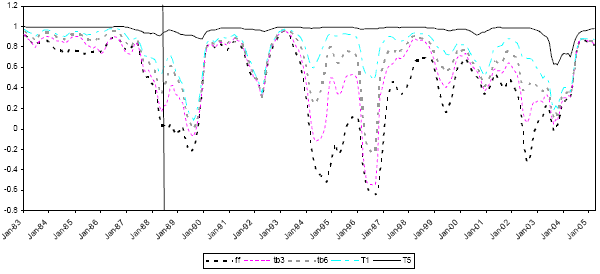In seeking to control interest rates, has the Federal Reserve become less relevant to equity investors? In his September 2007 paper entitled “The Unusual Behavior of the Federal Funds and 10-Year Treasury Rates: A Conundrum or Goodhart’s Law?”, Daniel Thornton examines the loss of correlation between the Federal Funds Rate (FFR) and long-term interest rates in the context of Goodhart’s Law, which states that “any observed statistical regularity will tend to collapse once pressure is placed upon it for control purposes.” Using monthly data for the FFR and the yields for Treasury instruments of various durations over the period 1/83-3/07, he concludes that:
- The correlation between monthly and quarterly changes in the 10-year Treasury note (T-note) yield and FFR not only changes in the mid-1990s but practically vanishes. The most likely point of breakdown is the late 1980s, after which there is no further statistically significant change in the relationship.
- The degree to which other Treasury instrument yields disconnect from the T-note yield increases as the maturity of the asset decreases.
- The breakdown in the relationship between FFR and long-term interest rates is a natural consequence of trying to use FFR to control, rather than respond to, macroeconomic conditions. Before the Federal Reserve began using FFR for policy purposes, both FFR and other interest rates responded to information that altered market expectations about economic fundamentals, thereby supporting a positive correlation. Once the Federal Reserve began trying to force a leading role for FFR, the correlation broke down.
The following chart, taken from the paper, shows the average difference between the actual funds rate and the Federal Open Market Committee’s (FOMC) funds rate target over the sample period. Prior to the period shown, during the 1970s, the funds rate responds to news about economic fundamentals in much the same way as market rates. In the 1980s, the FOMC shifts from using the funds rate as an operating instrument to a using it as a policy target. The average absolute difference between the actual funds rate and the funds rate target during 1/83-5/88 is 0.16%, with changes in the target an average of once every 1.8 months. Beginning about May 1988, the FOMC appears to increase control over the funds rate. The average absolute actual-target difference during 6/88-1/94 is just 0.07%, with changes in the target an average of once every 2.25 months. The average absolute difference during 2/94-3/07, after the FOMC began announcing policy actions, is only 0.03% with changes in the target an average of once every 3.25 months.

The next chart, also from the paper, shows the 24-month rolling correlation of various interest rates with the T-note yield, with all rates adjusted for the general downward trend in interest rates over the sample period. Rates included are FFR (ff), three-month Treasury bill (tb3), six-month Treasury bill (tb6), one-year T-note (T1) and five-year T-note (T5). The vertical line marks May 1988. The figure shows strong, steady positive correlations for all rates until late 1980s. After that point, the correlations are usually positive, but the relationships are increasing erratic as instrument maturity decreases. There are several periods of two years or longer when the correlation between the 10-year T-note and FFR is negative.

In summary, by trying to make the Federal Funds Rate lead rather than respond to economic fundamentals, the Federal Reserve causes a disconnect between short-tem and long-term interest rates.
For additional background on Goodhart’s Law, which is somewhat like the Heisenberg uncertainty principle, see “Goodhart’s Law: Its Origins, Meaning and Implications for Monetary Policy”.